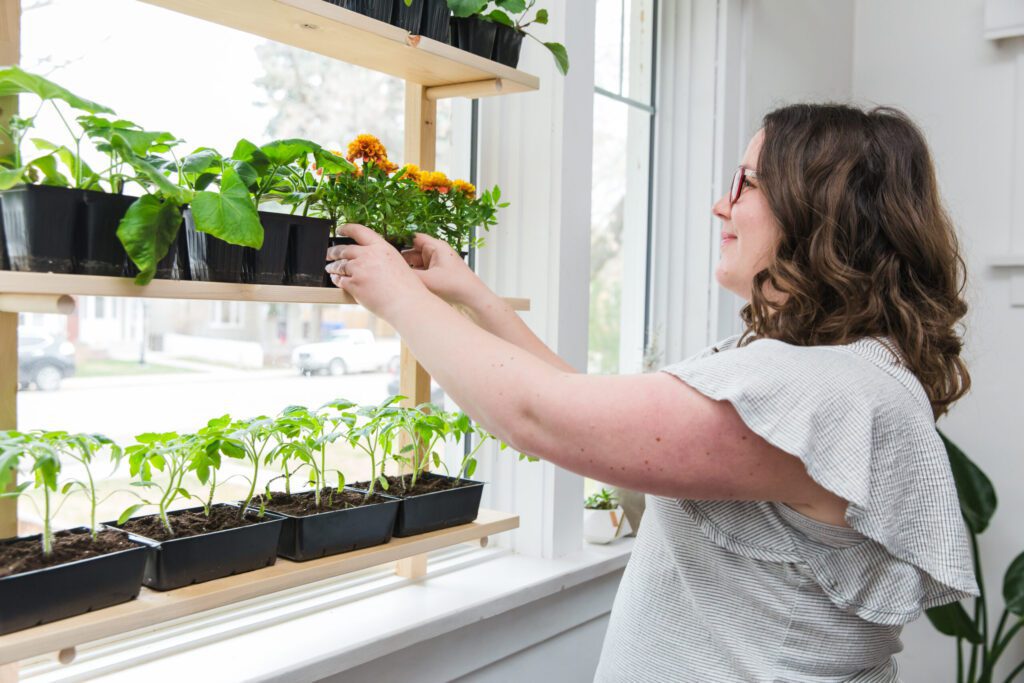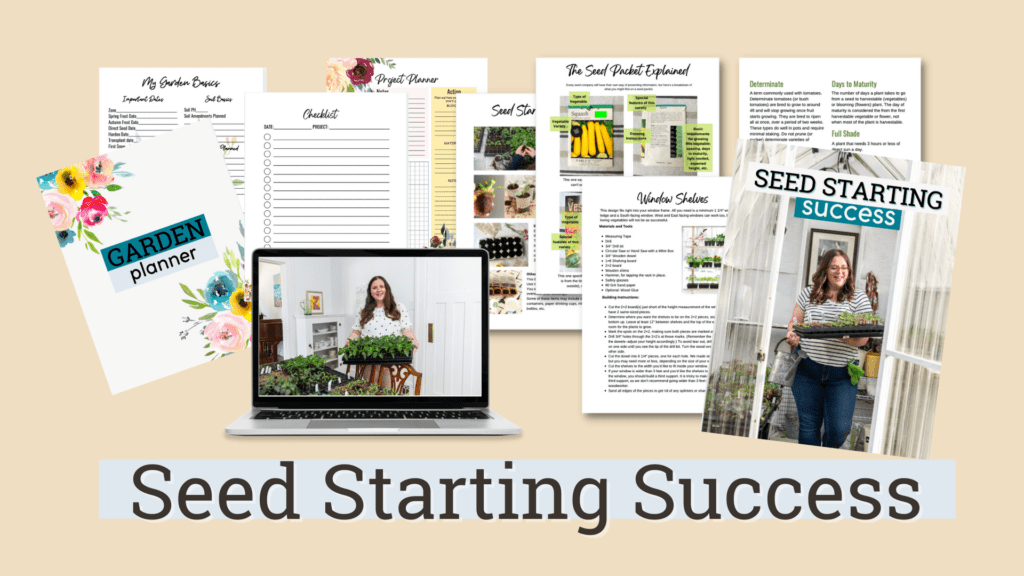When I was a little girl my grandmother started marigolds every winter in a little modified milk garden planter with her seeds from last year’s crop. I loved those marigolds in her brick planters and still think of her every time I see a marigold.
You really don’t need a grow light or other expensive equipment to start seeds. Seed starting from your window is relatively easy, but there are some limitations.

Disclaimer: This post contains affiliate links, which means that I make a small commission if you purchase anything, at no extra cost to you. You can read more about it in my Privacy Policy. Thank you for supporting Shifting Roots!
tips for seed starting from a window
1. South-Facing Windows Are Best
First of all, you must have a south-facing window. Even better: a south-facing corner window. East-facing windows can work too, but they must be larger. It also helps if the wall colour of the room is white or light.
If you try to start seeds from other directions, they will get too stretched out or “leggy.” In our last home, we had one (two?) windows that faced south and east. You’ll also have to turn your plants every day, so they don’t lean too much in one direction.

RELATED: 35+ CANADIAN SEED COMPANIES & NURSERIES TO ORDER THE GARDEN OR LANDSCAPE OF YOUR DREAMS
2. Don’t Start Too Early
I live near Saskatoon, Saskatchewan on the Canadian Prairies. There simply isn’t enough daylight in Zone 3 to sustain my seedlings until mid-February.
Wherever you live, don’t start your seeds until the Persephone days–the days generally between November and January when there are less than 10 hours of sunlight a day–are over. The easiest way to figure out when your Persephone days end is to go to the weather app on your phone and calculate how many hours there are from sunrise to sunset. When it reaches 10 hours of daylight, you’re good to plant!
3. Keep Your House Warm
Lastly, you must keep your house warm. This is not the time to be stingy with the thermostat! Many seeds require a temperature of around 21°C or 70°F to germinate. (That’s why you’ll see lots of ads for seedling heat mats in gardening magazines.)

Maximize your window’s growing space by making this DIY seed starting shelf.
You’re not the Greenhouse… yet.
Finally, don’t expect your seedlings to be just like the ones at the greenhouse. The gardeners at your local greenhouse are using grow lights, fertilizing, and watering correctly. That doesn’t mean you can’t succeed, just manage your expectations.
Organize Your Seeds by Week Needed to Seed Start
To start, read the directions on the seed packet to see when you can start those seedlings. Plants like artichokes, peppers, brussel sprouts, and flowers can be started as early as February. Tomatoes will need to be started in late March or early April.
Plants in our area typically go out on the May long weekend (around May 21st) as that is when the last frost has often passed. To figure out when to start your seeds, count the weeks backwards from that date. The Old Farmer’s Almanac has a handy tool to find your average frost dates, as well as your hardiness zone.
Resist the temptation to start your seeds earlier than recommended. It seems like such a good idea in February but it feels like a bad one in May when your seedlings have outgrown their containers and they’re difficult to harden off because they’re too big.
Then each week when it’s time to start a new batch of seeds, you won’t have to go searching for the right seeds, or worse yet, miss seed starting something altogether.
The Best Seed Starting Containers
Over the years, I’ve tried a lot of different containers to start my seeds. I’ve used egg cartons, reused the plastic containers seedlings come in from the store, Jiffy pods, random found objects like plastic yogurt containers, milk jugs, and clear plastic bakery containers, and made my own biodegradable newsprint containers.
Each type of container has its pros and cons.
1. Egg Cartons
Egg cartons are super cute and Pinterest-worthy, but they’re actually my least favourite method to seed start. (If you’ve come here from a pin with pictures of me starting seeds in egg cartons, I’m sorry!!)
They are not ideal to start seeds that require 6-8 weeks indoors. You’ll have to transplant your starters to larger containers as the roots become too long and start to grow into the egg carton itself. Only start vegetables that require 2-3 weeks indoors.

2. Jiffy Pods
Jiffy pods are so easy and fun to use–I love them! I also love that you can buy kits that are specifically made for windowsills. Save the plastic parts for reuse, and fill them with new Jiffy Pods each season.
Once the roots grow through the Jiffy pod (as pictured below), transfer to a larger container with more soil.

4. Repurposed Objects
You do not have to buy special flats to start your seeds! Use milk cartons and jugs or deeper plastic lids and plant away. You will either need to add drainage holes or be careful not to overwater your seedlings. I’ve made a list of 10 common household objects you can start saving in January and February so you’ll have lots of containers in March and April.
I also save the black plastic containers my annual flowers come in, so I can start my own annual flowers year after year in those same containers.
Check out this video for more details on how to use common household items.
5. Biodegradable Newspaper Containers
This is my favourite way to seed start. Follow this guide on how to make the containers, and start your seeds. If you need to move your seedlings, make sure that the containers have dried out. Otherwise, they will fall apart if you try to move them when wet.
The question I get asked most often about these containers is–do they really biodegrade? I’ll let this picture speak for itself…

Related: 6 Truths New Gardeners Should Know
Hints for Beginner Vegetable and Flower Gardeners
If you’ve never started seeds before, here are a few things to remember:
- Plants need time to germinate. This means your seeds won’t sprout for at least a week, sometimes more.
- Water when the soil feels dry to the touch. If the ground is pulling away from the edges, you’ve waited too long.
- Watering from the bottom of the tray, not the top of the plant, is best.
- The ground won’t look wet at first, but it will once the water has a chance to soak up.
- If you’re worried about overwatering or washing out your seeds, use a spray instead.
- Do all the fertilizer directions on the seed packet sound confusing? Water with a fertilizer formulated for seed starting (it will be labelled as such) once every two weeks to give your plants an extra boost. You can follow the exact fertilizer directions once you gain more confidence as a gardener.
- Start with new seeds. Some seeds can be viable for up to 10 years or more, but your germination rates decrease.
- Stick to seed starting two or three types of plants the first year. It’s easy to get overwhelmed.

Want to learn more about seed starting without grow lights? Here’s everything you need to know all in one place!
Seed Starting Results
I think it’s important for you to see what kind of results you can get from seed starting for your window. Here are my peppers from spring 2019 which were started from seed in front of my South-facing window. If you look closely, you can see that my seven-year-old son is crouched and hiding behind them–that’s how big they are!
It took me about 5 years to perfect my pepper growing process, but you can grab all my secrets here and get your peppers looking like this a lot faster.

If you liked this blog post, find me on Facebook, TikTok, and Instagram for more cold-climate vegetable gardening tips, delicious recipes, and cut flower goodness! I also make weekly videos over on my YouTube channel. I hope to see you there!
P.S. If you love the content I create for Shifting Roots, consider joining our community on Patreon. Your support means the world to me and I am grateful for each and every one of you!
HAVE YOU TRIED SEED STARTING, ONLY TO BE LEFT WITH STRETCHED-OUT SEEDLINGS AND DEAD PLANTS?
You’re not a bad gardener–you just need a little know-how. For the price of a few seed packets, you can stop wasting time and money and start growing seedlings that actually live, and you get to harvest. Don’t miss out on another growing season. Get your copy of Seed Starting Success now (videos included)!




CdnErin
Debbie Jespersen
Sarah